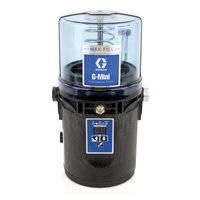The components of an automatic lubrication system
An automatic lubrication system consists of a pump with reservoir, a controller, metering devices, hose and fittings and accessories.
All automatic lubrication systems have a similar set-up. The pump and reservoir provide a steady flow of lubricant. A controller is necessary to activate and monitor the system. Metering devices ensure that the right amount of lubricant is dispensed to all lubrication points. Optional accessories enhance performance.
An automatic lubrication system is one that provides your equipment with the right amount of lubricant at the right time and in the right place – usually while the machine is in operation. It replaces a conventional lubrication system such as a grease gun. Discover the benefits of an automatic lubrication system in the article 7 significant advantages of automatic lubrication.
Suitable for all industrial applications
Graco provides a wide portfolio of complete automatic lubrication solutions that contain all the components necessary. Based on pneumatic, hydraulic or electric drives, they are suitable for all types of mobile or industrial applications, and can even be tailored to a solution for a specific application.
System components

- Pump and reservoir
- Controller
- Metering
- Hose and fittings
- Accessories
All automatic lubrication systems, be it a single line parallel or series progressive configuration, have a similar set-up, containing the following components.
Pump and reservoir
The pump and reservoir store and provide a steady flow of lubricant. Pumps come in all sorts and sizes, such as pumps for grease and oil with a wide variety of outputs to handle the smallest to the largest automatic lubrication jobs.


Controller
A controller is necessary to activate and monitor the system – although in many industrial in-plant applications, Graco often uses machine PLCs. If not, Graco provides time- or cycle-based controllers for any industrial application, suitable for cycle completion, high system pressure, low lube indication, low pressure and more.
Metering devices
Metering is at the heart of an automatic lubrication system, to ensure that the right amount of lubricant is dispensed to all the lubrication points. A metering system has to be accurate, reliable and durable, and capable of meeting all requirements such as long-runs, high pressure, continuous lube and others.


Hose and fittings
The hose is used to transport the lubricant from the reservoir to all lubrication points. Together with the fittings, the hose guarding and the field-installable hose end it spreads the lubricant to the bearings and other vital parts of an industrial installation.
Accessories
Optional accessories to further enhance performance can include monitoring and detection accessories such as simple shut-down devices, low level switches, blow-out discs for high-pressure detection or performance indicators.

5 Reasons Why You Need Automatic Lubrication
Protect your equipment and your employees by utilizing automatic lubrication to grease critical lube points.
Related Articles
7 significant advantages of automatic lubrication
Automatic lubrication systems offer many advantages such as reduced downtime and maintenance costs.
Single line parallel or series progressive: which automatic lubrication configuration to choose?
Single line parallel or series progressive: what’s the difference and when should you use one rather than the other?
How to avoid pin bushing wear and minimize repair costs
Auto Lube reduces contamination and wear of pin bushing, extend machine life and help avoid downtime.










